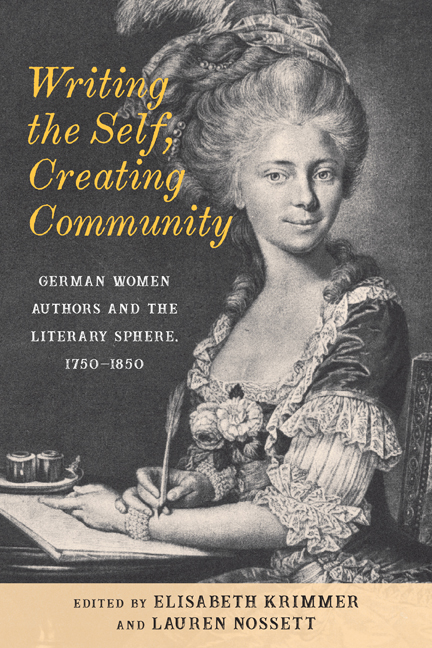Book contents
- Frontmatter
- Contents
- Acknowledgments
- Introduction
- Part I Writing a Community
- 1 Empowering Germany’s Daughters: On the Pedagogical Program and the Poetic Techniques of Sophie von La Roche
- 2 “Ich spreche lieber von guten Büchern”: Sophie von La Roche’s Concept of Female Authorship and Readership
- 3 Challenging Female Ideals: Marie-Elisabeth de La Fite’s Translation of Sophie von La Roche’s Geschichte des Fräuleins von Sternheim
- 4 Catherine II, Polyxene Büsching, and Johanna Charlotte Unzer: A Literary “Community of Practice”
- Part II Writing the Self
- 5 Ghostwriters: The Apparitional Author in Benedikte Naubert’s “Die Weiße Frau” (1792) and Sophie Albrecht’s Das Höfliche Gespenst (1797)
- 6 Vampirism Inverted: Pathology, Gender, and Authorship in Karoline von Günderrode’s “Die Bande der Liebe”
- 7 Wozu eine Amazonen—Literatur? Literary Creativity and Productivity in the Writings of Helmina von Chézy
- 8 Women Writers and the Märchenoma: Foremother, Identity, and Legacy
- Part III Writing toward Emancipation
- 9 The Illegitimacy of Authorship and the Legitimization of Passion in Agnes von Lilien
- 10 The Politics of the Female Body in Louise Aston’s and Fanny Lewald’s Writings through the Prism of the Romantic Theory of Sociability and Dialogue
- 11 Weibliche Irrsterne: Louise Otto and the Notion of Female Genius in Nineteenth-Century Germany
- Bibliography
- Notes on the Contributors
- Index
6 - Vampirism Inverted: Pathology, Gender, and Authorship in Karoline von Günderrode’s “Die Bande der Liebe”
Published online by Cambridge University Press: 01 October 2020
- Frontmatter
- Contents
- Acknowledgments
- Introduction
- Part I Writing a Community
- 1 Empowering Germany’s Daughters: On the Pedagogical Program and the Poetic Techniques of Sophie von La Roche
- 2 “Ich spreche lieber von guten Büchern”: Sophie von La Roche’s Concept of Female Authorship and Readership
- 3 Challenging Female Ideals: Marie-Elisabeth de La Fite’s Translation of Sophie von La Roche’s Geschichte des Fräuleins von Sternheim
- 4 Catherine II, Polyxene Büsching, and Johanna Charlotte Unzer: A Literary “Community of Practice”
- Part II Writing the Self
- 5 Ghostwriters: The Apparitional Author in Benedikte Naubert’s “Die Weiße Frau” (1792) and Sophie Albrecht’s Das Höfliche Gespenst (1797)
- 6 Vampirism Inverted: Pathology, Gender, and Authorship in Karoline von Günderrode’s “Die Bande der Liebe”
- 7 Wozu eine Amazonen—Literatur? Literary Creativity and Productivity in the Writings of Helmina von Chézy
- 8 Women Writers and the Märchenoma: Foremother, Identity, and Legacy
- Part III Writing toward Emancipation
- 9 The Illegitimacy of Authorship and the Legitimization of Passion in Agnes von Lilien
- 10 The Politics of the Female Body in Louise Aston’s and Fanny Lewald’s Writings through the Prism of the Romantic Theory of Sociability and Dialogue
- 11 Weibliche Irrsterne: Louise Otto and the Notion of Female Genius in Nineteenth-Century Germany
- Bibliography
- Notes on the Contributors
- Index
Summary
WHEN WE THINK OF THE VAMPIRE, we imagine a bite. But what if vampires were subtler in their approach? Over the centuries, transforming from folk monster to literary companion to suave cinematic lead, vampires have entranced their victims in many different ways. Around 1800, when Karoline von Günderrode wrote her elegy “Die Bande der Liebe” (The Bonds of Love), the vampire was known as a folk monster similar in some ways to a ghost and in others to an animated corpse. Yet what all vampires of this era had in common was a connection with the pathological, whether corporeal or mental in nature.
Günderrode's poem does not thematize the vampire as explicitly as Gottfried August Bürger's ballad “Lenore” (1774) or Johann Wolfgang von Goethe's “Die Braut von Korinth” (1797), both of which deal with a dead lover who lures his living love to join him in death. Yet, there are lexical and thematic similarities that call to mind a kind of vampirism. Goethe's vampire drinks wine that resembles blood, an act he describes with the words “gierig” (greedily) and “schlürfte” (slurped), echoed in Günderrode's description of spirits of the dead sucking greedily (“schlürfen sie gierig mir aus”). The similar vocabulary suggests that Günderrode was taking part in a contemporary discourse surrounding the (folkloric) vampire, which her readers would recognize as such. Günderrode's poem is interesting for the subtle directional change of vampiric action: the initial “bite,” so to say, is not that of greedy spirits but a gentle breath of air passed from one lover to another. Surprisingly, this gentle breath (we might say inspiration) attracts a violent reaction of underworld shades, like a cold rush of air into a warm space.
But what does a vampire have to do with writing? In the following I argue that Günderrode's reverse vampirism—breath rather than bite, healing rather than infecting—is a response to eighteenth-century discourses that pathologize female writing. In Germany at the end of the eighteenth century, reading was rapidly increasing in popularity. At the same time, more and more women began to publish original works, whether under their own names or under pseudonyms.
- Type
- Chapter
- Information
- Writing the Self, Creating CommunityGerman Women Authors and the Literary Sphere, 1750–1850, pp. 138 - 159Publisher: Boydell & BrewerPrint publication year: 2020



